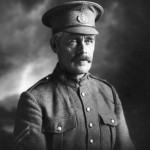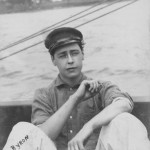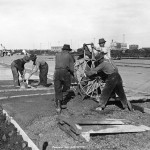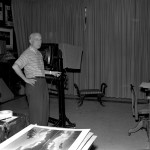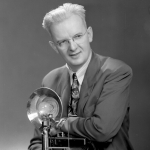They were in the right place at the right time, and these pioneer photographers left behind a remarkable visual record of a city reaching earnestly ahead. Here’s a quick look at a few of them and some samples of their legacy.
Mortimer Burgess
In a November 1920 advertisement, Mortimer Burgess boasted that he had photographed more than 8,000 children in the 14 years since he arrived in the Edmonton area in 1906. “Burgess, the Baby Photographer,” a 1911 profile in the Strathcona Plaindealer called him. “A great friend of the little folks.”
From his studio on Whyte Avenue, he also shot family portraits and captured moments in time, like soldiers going off to war. Nearly 400 of the images, all on glass negatives, are now held at the City of Edmonton Archives.
Burgess was born in England in 1881 when the camera was barely a working apparatus, and trained as a photographer in London and Hastings. He sought his future in Canada and started his business with an office in the Strathcona Post Office.
He sold his Burgess Photo Studio in 1934 and went to work for McDermid Studios and, in 1946, became owner of Alderson Studio at 10269 97th Street. He retired in 1951 and passed away in 1963, but the studio bearing his name continued operations in Strathcona until 1972.
Percy C. Byron and Gustave H. May
The Byron-May Company was a photo engraving venture established in 1906 by Percy C. Byron, the son of famous New York photographer Joseph Byron. Percy arrived in Edmonton in 1906 from the Big Apple, determined to find himself a homestead or ranch. But he couldn’t resist a business opportunity, and within 24 hours had telegraphed his father to ship him one complete engraving plant.
Byron set up a shop on First Street (now 101st) and, by August 1906, was producing photographic images utilizing the only equipment of its kind in the northwest. A year later Byron was joined by his brother-in-law Gustave H. May — another New Yorker! — and the Byron-May Company was founded.
“Engravers, Half-Tone Work, Commercial Photography, Art Illustrating and One of the Most Complete Institutions of Its Kind in Canada,” their ads proclaimed. When the partners needed more room for their thriving venture, they found an investor and erected a two-storey brick building at 252 Howard Avenue (now 100A Street). By 1909 the business occupied more than 3,500 square feet.
May was elected to Edmonton City Council in 1912 and served until 1914. With the coming of war, business fell on hard times and their company was bought out in 1917 by McDermid Engraving. Misters Byron and May moved their families back to the United States the following year, and Byron specialized in steamship photography.
Alfred Blyth
In a career that spanned more than 60 years, Alfred Blyth captured the growth of a city and its people through his camera lens and was one of Alberta’s most acclaimed photographers. Blyth was born in Ayrshire, Scotland in 1901 and came to Edmonton in 1913 with his widowed mother, four brothers and three sisters. The family moved into a house at 9716 92nd Street that he was to call home for most of the rest of his life.
Blyth began his photographic apprenticeship with the Byron-May Company in 1916 and then went to work for McDermid Studios until he went into business for himself in 1928. In 1939 he was official photographer for the royal visit of King George VI and Queen Elizabeth.
He was granted the same honour for the visit of Princess Elizabeth and Prince Philip, and again when they returned in 1959 as Queen Elizabeth II and the Duke of Edinburgh. He filmed the opening of the legislature at the beginning of the Aberhart administration – the first time such filming was allowed.
But it was images he captured for his own pleasure that eventually won him the highest international acclaim of his illustrious career. At one Amsterdam competition in 1953, his photograph of the serenity of Maligne Lake in early morning entitled Break O’Day won the gold medal, beating out 1,500 other entries. Such salon photography earned him high praise on the international stage, and in a rating of a thousand of the world’s leading photographers, Blyth placed 58th.
His photographic collection of 25,000 images was acquired by the Provincial Archives in 1972 and formed the backbone for an extensive exhibit at the Provincial Museum covering 1928 to his retirement in 1970. When he was honoured with an Edmonton Historical Board Recognition Award in 1978, he was frail but his eyes still sparkled with the memories of all he had seen and captured in a lifetime through the lens. He died August 13th, 1980 at the age of 79.
McDermid Studios
When Frederick Glen McDermid opened his studio and engraving plant in downtown Edmonton on September 1st, 1912, the city, like photography itself, was growing rapidly in popularity. McDermid was one of those who arrived with the waves of new settlers, drawn by opportunity and the promise of a better future. He had been born in 1880 and lived in Petrolia, Ontario before travelling to various cities in Canada and the United States.
His McDermid Engraving Company was located at 123 Rice Street (101A Avenue near 101st Street). One newspaper account said the premises included “an up-to-date art department, model dark room and the latest approved cameras and machinery and other apparatus for making zinc etchings and half-tones from drawings and designs for maps, etc.”
McDermid Engraving moved to 10133 101st Street in 1922, and the following year McDermid left Edmonton for Oregon and Joseph Tyrell became the president of the company. The name of the business was changed to McDermid Studios, which endures as an Edmonton company to this day. From 1929 to 1940 the company was owned by Charles R. Morrison, one of the original shareholders and former managing editor of the Edmonton Journal. His daughter, Muriel, took over the company and her husband, Bert Hollingshead, became manager.
The studio moved to 10024 101st Street and later to 9850 112th Street. After Morrison died in 1967 Muriel’s son, David, operated the business, and then it was overseen by Charles Morrison’s great-granddaughter Gay and her husband Mark Perry.
Most of the early McDermid photographs — those taken between 1912 and 1929 — were sold and donated to the Glenbow Archives in Calgary between 1957 and 1972. Today the McDermid Studio fonds comprise more than 17,000 photographs in the Glenbow collection.
Hubert Hollingworth
One of my favourite Hubert Hollingworth images shows a row of coal trucks lined up in front of the Beverly Coal Company. If you look closely, you’ll see the drivers standing on the sideboards; working class men doing a working class job.
Capturing the “working class heroes” was a favourite pursuit for Hollingworth. From 1924 until his retirement in 1976, he chronicled the life of Edmonton with an eye for a captivating image guided by his heart.
Hollingworth was born in Lloydminster in 1912, and when he was 12 came to Beverly and began as an apprentice with Bell Studios. While still in his teens, he took to the air with bush pilot friend Wilfrid “Wop” May, leaning out the open cockpit of a Tiger Moth biplane, clicking away, the wind tearing through his hair.
Hollingworth married Violet Faulkner in 1936, and the couple moved into the back of his studio at 118th Avenue and 95th Street. The lean years during the Second World War only inspired Hubert’s creativity, and when he couldn’t obtain colour film stock, Violet hand-coloured their home movies.
With the war still underway, Hubert closed the shop and took a job as aerial photographer for the U.S. Army engineers building the Alaska Highway. He later worked for Edmonton’s famous McDermid Studios and took aerial and society photos for the Edmonton Journal and now defunct Edmonton Bulletin, capturing elements of life that most other photographers didn’t document.
From 1976 until shortly before his death in 1988 at age 75, Hollingworth copied more than 12,700 photographic images and slides for the City of Edmonton Archives and volunteer groups. The City of Edmonton Archives collection of his work numbers more than 2,000 photos and ranks as the first donation of its size from a professional photographer. The man is gone but his legacy is reaching new eyes — the greatest tribute a photographer could ask.
© Lawrence Herzog 2011, All Rights Reserved
Top Photo:
Alfred Blyth in his studio, April 20, 1972. Provincial Archives of Alberta, A9877.



